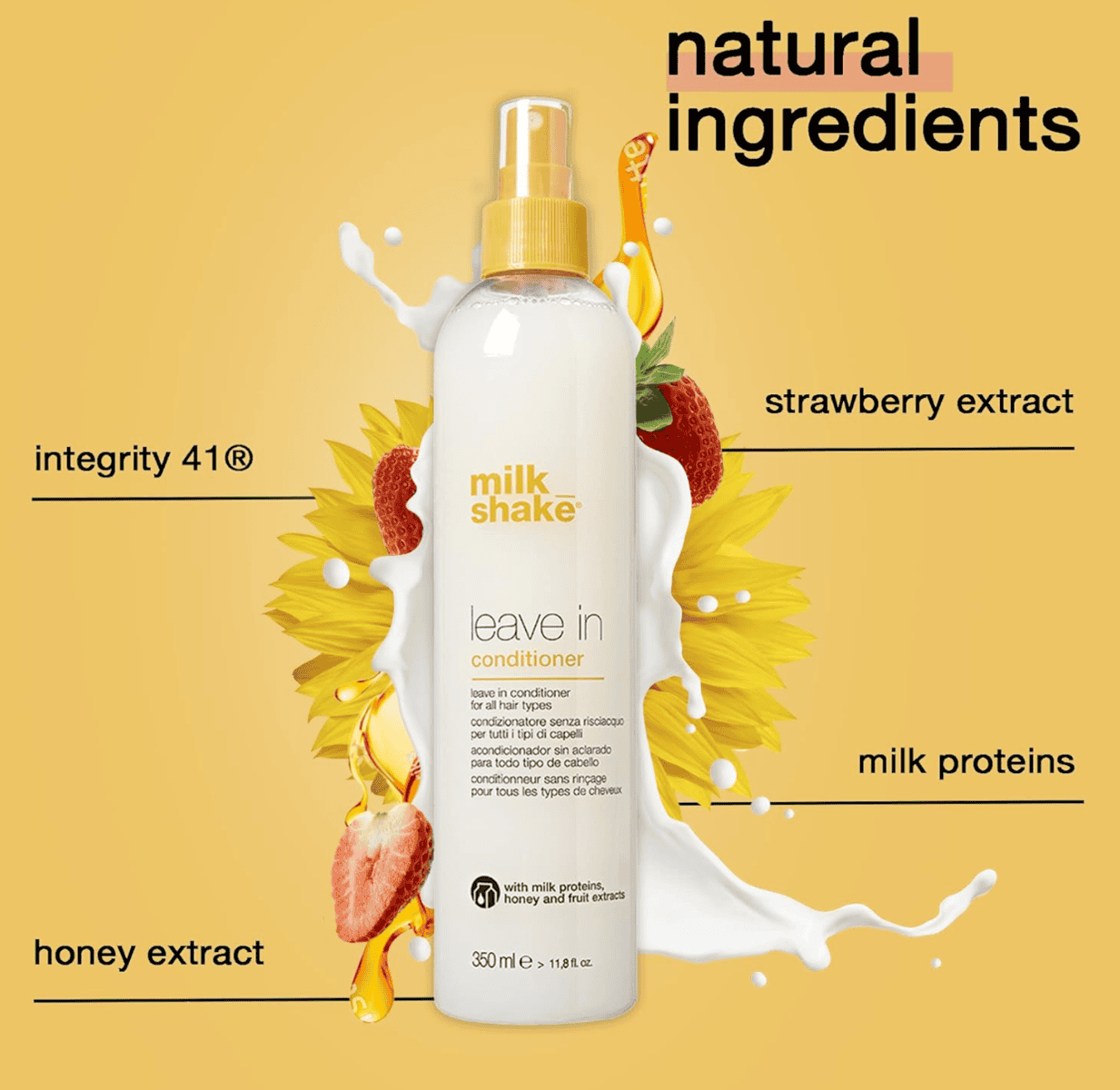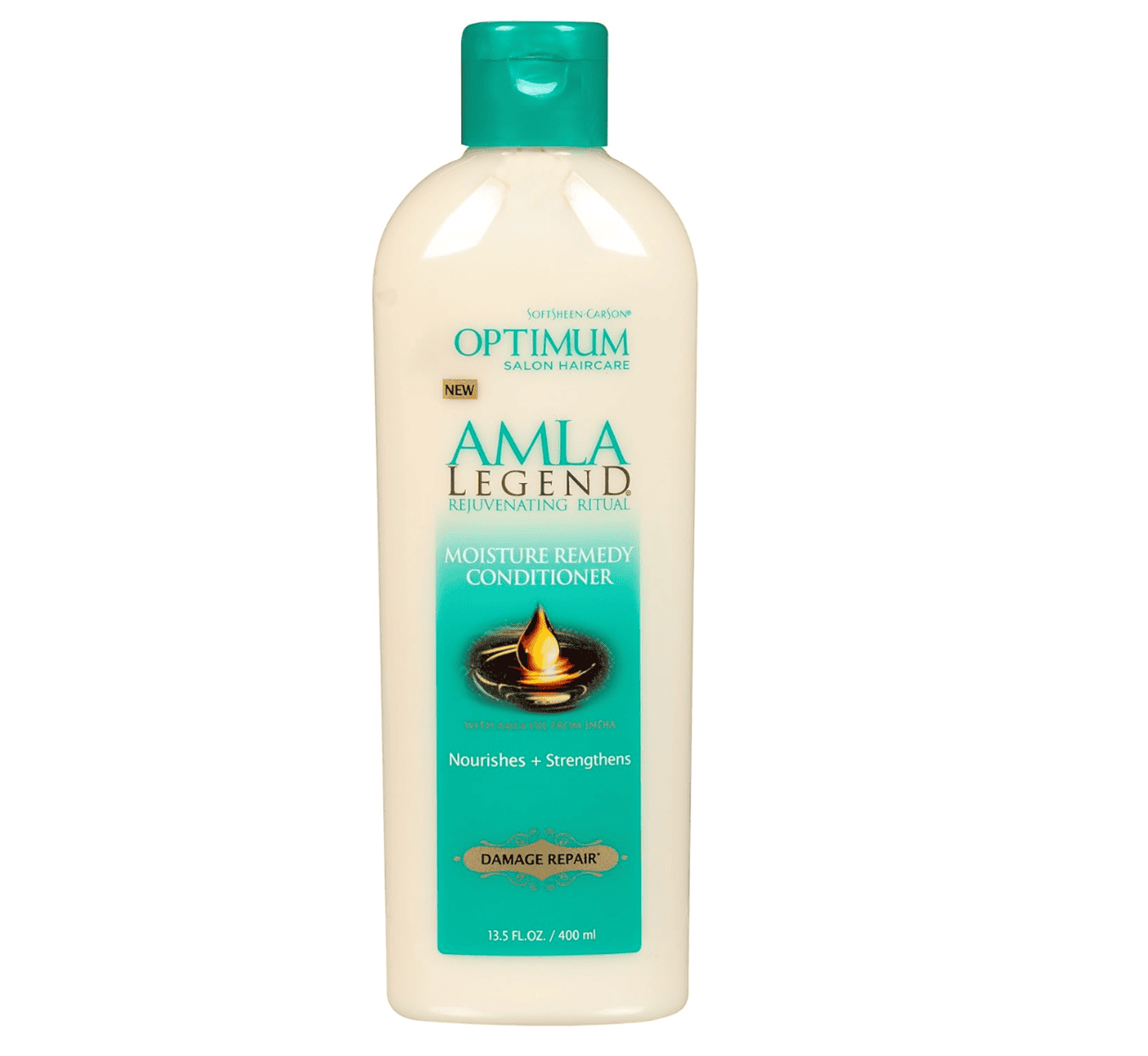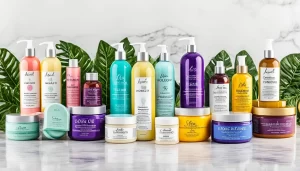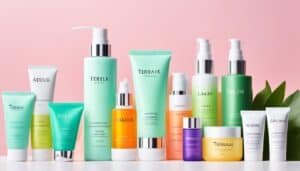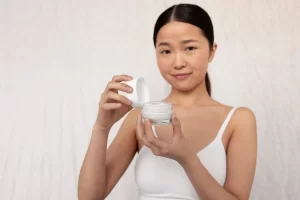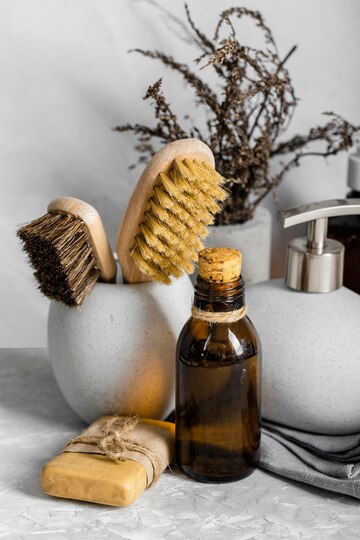
Ultimate Guide to Relaxed Haircare Essentials
Did you know that over 70% of African American women in the United States have relaxed hair?
Relaxed hair requires a specialized haircare routine to maintain its strength, health, and overall beauty.
Whether you’re new to relaxed hair or looking to improve your current routine, this guide will provide all the information you need for beautiful, resilient locks.
Key Takeaways:
- Relaxed haircare is essential for maintaining strong and healthy hair.
- Over 70% of African American women have relaxed hair in the United States.
- This guide will provide all the necessary information for a successful relaxed haircare routine.
- Proper product selection is crucial for the health of relaxed hair.
- Maintaining a consistent haircare routine is key to preventing breakage and promoting overall hair health.
The Basics of Relaxed Haircare
When it comes to taking care of relaxed hair, there are a few key factors to consider.
In this section, we will explore the basics of relaxed haircare, including how to establish a haircare routine tailored to your specific needs.
Benefits and Challenges of Relaxed Hair
Relaxed hair has its own set of unique benefits and challenges. One of the primary benefits is the versatility it offers – relaxed hair can be styled in various ways, from sleek and straight to voluminous and bouncy.
Additionally, relaxed hair tends to require less maintenance on a daily basis compared to natural hair.
However, it’s essential to note the challenges of managing relaxed hair.
The chemical processes used to relax the hair can weaken its structure, making it more susceptible to breakage and damage.
Therefore, proper care and maintenance are crucial to ensure the health and strength of your relaxed hair.
Establishing a Haircare Routine
Creating a consistent and effective haircare routine is essential for promoting the health and vitality of your relaxed hair. Here are some steps to help you establish a personalized haircare routine:
- Cleansing: Start by using a gentle shampoo specifically formulated for relaxed hair. Look for products that are hydrating and sulfate-free to avoid stripping the hair of essential oils.
- Conditioning: Follow up with a moisturizing conditioner to restore hydration and nourishment to your hair. Consider using a deep conditioner once a week to provide extra moisture and strength.
- Moisturizing: To combat dryness, it’s important to moisturize your relaxed hair regularly. Use a leave-in conditioner or moisturizer to keep your strands hydrated and prevent breakage.
- Protective Styling: Opt for protective styles such as braids, twists, or updos to minimize manipulation and reduce the risk of damage. This will help to preserve the health of your relaxed hair.
- Heat Styling: If you choose to use heat styling tools, always apply a heat protectant spray to shield your hair from excessive heat. Additionally, avoid using high heat settings and limit the frequency of heat styling to prevent damage.
Factors to Consider
When caring for relaxed hair, there are several important factors to consider:
- Hydration: Relaxed hair is prone to dryness, so it’s crucial to keep your hair well-hydrated. Using moisturizing products and incorporating deep conditioning treatments into your routine can help maintain moisture balance.
- Protein Balance: Relaxed hair needs a balance of moisture and protein to remain healthy and strong. Consider incorporating protein treatments into your routine to strengthen the hair shaft and prevent breakage.
- Protection: Protecting your relaxed hair from heat, UV rays, and harsh environmental factors is essential. Use heat protectants, wear protective hairstyles, and consider using satin or silk materials when sleeping to minimize friction and damage.
By understanding the basics of relaxed haircare and following a consistent haircare routine, you can ensure that your relaxed hair remains healthy, strong, and beautiful.
Choosing the Right Products for Relaxed Hair
Finding the best products for your relaxed hair is essential to maintain its health and beauty.
With a wide range of options available on the market, it can be overwhelming to choose the right ones.
In this section, we will provide valuable insights into the essential products specifically designed for relaxed hair.
From shampoos to styling products, we’ll help you build a reliable haircare routine that caters to the unique needs of your relaxed locks.
The Importance of Shampoo and Conditioner
A good shampoo and conditioner are the foundation of any haircare routine.
When choosing products for your relaxed hair, look for formulas that are moisturizing, gentle, and sulfate-free.
Sulfates can strip the hair of its natural oils, leading to dryness and breakage.
Opt for shampoos and conditioners that are enriched with nourishing ingredients such as argan oil, shea butter, and keratin.
These ingredients help to hydrate and strengthen your hair, promoting overall health and resilience.
Leave-In Treatments for Added Moisture and Protection
Leave-in treatments are a great addition to your relaxed haircare routine. They provide extra moisture and protection throughout the day, keeping your hair hydrated and nourished.
Look for leave-in treatments that contain ingredients like aloe vera, coconut oil, and silk proteins.
These ingredients help to lock in moisture, prevent frizz, and protect your hair from environmental damage.
Apply the treatment to damp hair and distribute it evenly from roots to ends for maximum benefits.
Styling Products to Enhance and Protect
Styling products play a significant role in achieving the desired look for your relaxed hair while providing protection against heat and humidity.
When selecting styling products, consider your desired hairstyle and the level of hold you need.
Choose products that are lightweight and non-greasy, as heavy products can weigh down your hair and cause build-up.
Look for stylers that offer heat protection to shield your hair from damage caused by styling tools.
Pro Tip: It’s essential to avoid using excessive heat and always use a heat protectant spray or serum before applying heat to your relaxed hair. This will help minimize damage and maintain the integrity of your strands.
Featured Product: Shea Moisture Jamaican Black Castor Oil Strengthen & Restore Shampoo
If you’re looking for a high-quality shampoo specifically formulated for relaxed hair, consider Shea Moisture Jamaican Black Castor Oil Strengthen & Restore Shampoo.
This popular product combines the benefits of Jamaican black castor oil, shea butter, and peppermint oil to cleanse, nourish, and strengthen your hair.
It helps to promote healthy hair growth and restores natural strength to relaxed hair that is prone to breakage.
To achieve the best results, apply the shampoo to wet hair, lather, and massage into your scalp. Rinse thoroughly and follow up with a moisturizing conditioner for optimal hydration and manageability.
Choosing the right products for your relaxed hair is a crucial step in maintaining its health and beauty.
By incorporating these essential products into your haircare routine, you can achieve strong, resilient, and gorgeous hair that turns heads.
Defy Breakage: The Ultimate Solution for Relaxed Hair
When it comes to caring for relaxed hair, finding the right products that help to strengthen and protect your strands is essential.
This is where the Defy Breakage line from Optimum Salon Haircare comes in.
Specifically formulated for relaxed hair, these products deliver the ultimate solution for maintaining healthy and resilient locks.
Defy Breakage offers a range of high-quality haircare products designed to tackle the unique challenges of relaxed hair, including the Defy Breakage No Lye Relaxer, Optimum Care Defy Breakage No Lye Hair Relaxer Regular Strength, Optimum Defy Breakage Leave-In Strengthener, Optimum Defy Breakage Shampoo, and more.
| Product | Description |
|---|---|
| Defy Breakage No Lye Relaxer | A potent relaxer that effectively straightens and smoothens the hair while minimizing breakage. |
| Optimum Care Defy Breakage No Lye Hair Relaxer Regular Strength | A gentle relaxer suitable for regular use, providing maximum protection against breakage. |
| Optimum Defy Breakage Leave-In Strengthener | A nourishing leave-in treatment that strengthens and moisturizes the hair, promoting resilience and preventing breakage. |
| Optimum Defy Breakage Shampoo | A revitalizing shampoo infused with powerful ingredients that gently cleanse the hair while fortifying it against breakage. |
These products are enriched with essential vitamins, minerals, and proteins that penetrate deep into the hair shaft, restoring strength, elasticity, and moisture.
By using the Defy Breakage line as part of your relaxed haircare routine, you can defy breakage and enjoy hair that is healthier, shinier, and more manageable.
Optimum Salon Haircare’s Defy Breakage line is a game-changer for relaxed hair. The products not only deliver exceptional results but also provide the protection and nourishment that relaxed hair needs to thrive. Say goodbye to breakage and hello to stronger, more beautiful hair.
Establishing a Relaxed Haircare Routine
A consistent haircare routine is essential for maintaining healthy relaxed hair.
By following a personalized routine, you can ensure that your locks stay nourished, moisturized, and resilient.
Here is a step-by-step guide to help you create an effective haircare routine for your relaxed hair:
- Cleansing: Start your routine by cleansing your hair with a gentle shampoo designed for relaxed hair. This will help to remove any product buildup or impurities without stripping away natural oils.
- Conditioning: After shampooing, apply a moisturizing conditioner to replenish and hydrate your hair. Focus on the ends, where relaxed hair tends to be more prone to dryness and breakage. Leave the conditioner on for a few minutes before rinsing thoroughly.
- Deep Conditioning: Treat your hair to a deep conditioning treatment at least once a week. This will help to restore moisture, strengthen your strands, and improve overall hair health. Apply the deep conditioner generously and leave it on for the recommended amount of time before rinsing.
- Moisturizing: Moisture is key for maintaining relaxed hair. After rinsing out the conditioner or deep conditioner, apply a leave-in moisturizer or a lightweight hair oil to keep your hair hydrated throughout the day. Pay extra attention to the ends, as they are more susceptible to dryness and breakage.
- Protective Styling: Consider incorporating protective styles into your haircare routine. These styles, such as buns, braids, or twists, help to minimize manipulation and protect your hair from daily wear and tear. They also promote length retention and allow your hair to thrive.
- Heat Styling Precautions: If you choose to use heat styling tools, always apply a heat protectant spray or serum to shield your hair from heat damage. Use the lowest heat setting possible and avoid excessive heat exposure to prevent dryness, breakage, and frizz.
- Nighttime Routine: Before going to bed, wrap your hair in a satin or silk scarf or use a satin pillowcase to minimize friction and prevent moisture loss. This will help to maintain the smoothness and health of your relaxed hair overnight.
Remember, consistency is key when it comes to establishing a relaxed haircare routine.
Stick to the steps mentioned above and tailoryour routine based on your hair’s specific needs.
With proper care and attention, you can achieve and maintain beautiful, healthy relaxed hair.
Maintaining Healthy Relaxed Hair
Proper maintenance is crucial for keeping your relaxed hair healthy, strong, and vibrant. By following these professional relaxed haircare tips, you can ensure that your hair remains in optimal condition.
Preventing Breakage
Breakage is a common concern for individuals with relaxed hair.
To prevent breakage, it is essential to handle your hair with care and minimize stress on the strands. Here are some tips:
- Detangle your hair gently, starting from the ends and working your way up, using a wide-tooth comb or your fingers.
- Avoid excessive combing or brushing, as this can lead to mechanical damage and breakage.
- Protect your hair while sleeping by wrapping it in a satin or silk scarf or using a silk pillowcase to minimize friction.
- Avoid tight hairstyles, such as high ponytails or buns, which can cause tension and breakage around the hairline and edges.
Ensuring Moisture Balance
Relaxed hair tends to be more prone to dryness, which can lead to brittleness and breakage.
To maintain optimal moisture balance, consider the following tips:
- Use a moisturizing shampoo and conditioner specifically formulated for relaxed hair to replenish moisture and nourish the strands.
- Regularly deep condition your hair to provide intense hydration and nourishment.
- Avoid over-washing your hair, as frequent washing can strip away the natural oils that help retain moisture.
- Seal in moisture by applying a leave-in conditioner or hair oil to damp hair after washing.
Protecting Against Heat Damage
Heat styling tools, such as flat irons and curling irons, can cause damage to your relaxed hair if not used properly.
Here’s how you can protect your hair from heat damage:
- Apply a heat protectant spray or serum to your hair before using heat styling tools.
- Use the lowest heat setting possible on your styling tools to minimize damage.
- Avoid using heat styling tools too frequently, opting for heatless hairstyles or using alternative styling methods whenever possible.
Promoting Overall Hair Health
In addition to the above tips, there are several other practices you can incorporate into your haircare routine to promote overall hair health:
- Trim your hair regularly to remove split ends and prevent them from traveling up the hair shaft.
- Protect your hair from harsh weather conditions, such as excessive sun exposure or extreme cold, by wearing a hat or scarf.
- Follow a balanced diet rich in vitamins, minerals, and protein to nourish your hair from within.
- Consider incorporating hair vitamins or supplements into your routine, after consulting with a healthcare professional.
“Proper maintenance is key to keeping your relaxed hair healthy and vibrant. By following these tips, you can prevent breakage, ensure moisture balance, protect against heat damage, and promote overall hair health.” – Professional Hair Stylist
| Tips for Maintaining Healthy Relaxed Hair |
|---|
| Gently detangle your hair using a wide-tooth comb or your fingers. |
| Avoid excessive combing or brushing to minimize mechanical damage. |
| Protect your hair while sleeping with a satin or silk scarf or pillowcase. |
| Avoid tight hairstyles that can cause tension and breakage. |
| Use moisturizing shampoo and conditioner specifically formulated for relaxed hair. |
| Regularly deep condition your hair to provide intense hydration. |
| Avoid over-washing your hair to retain natural oils. |
| Seal in moisture with a leave-in conditioner or hair oil. |
| Apply a heat protectant before using heat styling tools. |
| Use the lowest heat setting possible on your styling tools. |
| Avoid excessive use of heat styling tools. |
| Trim your hair regularly to remove split ends. |
| Protect your hair from harsh weather conditions. |
| Follow a balanced diet and consider hair vitamins or supplements. |
Common Myths and Misconceptions About Relaxed Hair
Relaxed hair often faces a lot of skepticism and misinformation. Let’s debunk some common myths and misconceptions to help you make informed decisions about your haircare routine.
-
- Myth: Relaxed hair is unhealthy
The belief that relaxed hair is automatically unhealthy is false. With proper care and maintenance, relaxed hair can be healthy and resilient.
-
- Myth: Relaxed hair is better than natural hair
Whether relaxed hair is better than natural hair is subjective and depends on personal preference. Both hairstyles have their own unique beauty and require different care routines.
-
- Myth: Relaxed hair is always unhealthy
While relaxed hair can be prone to dryness and breakage if not properly cared for, it does not automatically mean that all relaxed hair is unhealthy. Regular trims, deep conditioning, and protective styling can help maintain healthy relaxed hair.
-
- Myth: Relaxed hair is bad for your scalp
When applied and maintained correctly, relaxers are not inherently bad for your scalp. It’s important to follow the instructions and consult with a professional stylist to minimize any potential scalp irritations.
-
- Myth: Relaxed hair is permanent
Contrary to popular belief, relaxed hair is not permanent. As new hair grows, the relaxed hair will eventually grow out, requiring touch-ups to maintain the desired look.
-
- Myth: Relaxed hair cannot be healthy
Relaxed hair can be healthy when the right products and techniques are used. Proper moisturizing, deep conditioning, and a consistent haircare routine can promote healthy and nourished relaxed hair.
-
- Myth: Relaxed hair cannot be colored
Relaxed hair can be safely colored if done by a professional stylist and with appropriate products. However, it’s essential to ensure that the hair is in good condition and properly maintained before undergoing any coloring process.
-
- Myth: Relaxed hair cannot be curly
Relaxed hair can be styled in various ways, including achieving curls. Using curling techniques like flexi rods, perm rods, or curling wands, you can add curls to your relaxed hair, creating a versatile and beautiful look.
-
- Myth: Relaxed hair is always damaged
While relaxed hair can be susceptible to damage if not properly cared for, it doesn’t mean that all relaxed hair is damaged. Regular trimmings, deep conditioning treatments, and a healthy haircare routine can help mitigate damage and promote overall hair health.
“Remember, the key to maintaining healthy relaxed hair is proper care and maintenance. By debunking these myths, you can make informed decisions about your haircare routine.”
Now that we’ve cleared up some common misconceptions, let’s explore frequently asked questions about relaxed hair in the next section.
Click Here To Learn More
Frequently Asked Questions About Relaxed Hair
Having questions about relaxed hair is completely normal.
In this section, we will address some of the most frequently asked questions about relaxed hair, including hair growth, maintenance, coloring, and more.
We aim to provide clear and concise answers to common concerns and queries. Take a look below to find answers to your burning questions:
- How fast does relaxed hair grow?
Relaxed hair grows at an average rate of half an inch per month. However, individual growth can vary depending on factors such as genetics, overall health, and hair care practices.
- What are some tips for maintaining relaxed hair?
Maintaining relaxed hair requires a consistent hair care routine. Some essential tips include:
- Moisturizing regularly to prevent dryness and breakage.
- Protective styling to minimize manipulation and friction.
- Trimming split ends regularly to maintain the health of your hair.
- Limiting the use of heat styling tools to prevent heat damage.
- Can I color my relaxed hair?
Yes, you can color your relaxed hair. However, it’s important to be cautious and follow proper hair care practices to minimize damage. Seek professional advice or consult an experienced colorist to ensure the best results and minimize potential harm to your hair.
- How often should I wash my relaxed hair?
The frequency of washing your relaxed hair depends on various factors, such as scalp condition, oiliness, and product buildup. As a general guideline, washing your hair every 1-2 weeks is recommended. However, adjust the frequency based on your specific needs and preferences.
If you have more questions or specific concerns about relaxed hair, feel free to consult a professional stylist or trichologist who can provide personalized advice and guidance.
Tips for Achieving and Maintaining Healthy Relaxed Hair
When it comes to relaxed haircare, following a proper routine and implementing effective techniques is key to maintaining the health and strength of your locks.
In this section, we will share some top tips and tricks for achieving and maintaining healthy relaxed hair.
These tips, ranging from protective styling to deep conditioning, will help you achieve your hair goals while ensuring your strands remain strong and resilient.
1. Protect Your Hair
To prevent breakage and damage, it’s important to protect your relaxed hair.
Consider using protective styles such as braids, buns, or twists, which help to minimize manipulation and tension on your strands.
Additionally, using a satin or silk pillowcase and wearing a silk or satin scarf or bonnet can aid in reducing friction and maintaining moisture in your hair.
2. Invest in Regular Deep Conditioning
Deep conditioning is a crucial step in maintaining healthy relaxed hair.
It helps to restore moisture, strengthen the hair follicles, and improve overall elasticity.
Make sure to incorporate a hydrating deep conditioner into your weekly haircare routine to nourish and rejuvenate your strands.
3. Limit Heat Styling
Excessive heat styling can lead to dryness, breakage, and damage to your relaxed hair.
To maintain the health of your strands, it’s important to limit the use of heat styling tools such as flat irons, curling wands, and blow dryers.
When using heat, always apply a heat protectant spray or serum to minimize damage.
4. Moisturize Regularly
Relaxed hair tends to be drier and more prone to breakage. To combat this, make sure to moisturize your hair regularly.
Use a lightweight leave-in conditioner or moisturizer to add moisture to your strands, focusing on the ends where dryness is most common.
5. Trim Regularly
Regular trims are essential for maintaining the health of your relaxed hair.
Trimming helps to remove split ends and prevent breakage, allowing your hair to grow longer and stronger. Aim to get a trim every 8-12 weeks or as needed.
“Taking care of your relaxed hair requires consistency and patience. By implementing these top tips into your haircare routine, you can achieve and maintain beautiful, healthy relaxed hair.”
Remember, everyone’s hair is unique, so it’s important to find the techniques and products that work best for you.
By following these tips and tailoring them to your specific needs, you can enjoy the benefits of strong, resilient, and beautiful relaxed hair.
The Importance of Protein in Relaxed Haircare
Protein plays a crucial role in maintaining the health and strength of relaxed hair. It is responsible for repairing damaged hair fibers and promoting overall hair growth.
Without adequate protein, relaxed hair can become weak, brittle, and prone to breakage.
But how do you know if your hair needs protein? One way to determine this is by assessing the condition of your hair.
If your hair feels weak, lacks elasticity, and constantly breaks, it may be a sign that it lacks protein.
Additionally, if you frequently use heat styling tools, chemical treatments, or if your hair has been over-processed, protein replenishment becomes even more important.
Fortunately, there are several products available that can help restore and maintain protein balance in relaxed hair.
These products often come in the form of protein treatments, masks, or conditioners specifically formulated for relaxed hair.
They typically contain key ingredients such as hydrolyzed proteins, amino acids, and keratin, which penetrate the hair shaft and strengthen the hair from within.
One such product is the “Optimum Salon Haircare Amla Legend Miracle Repair Remedy Cream” (image below), which is enriched with a blend of amla oil, keratin, and amino acids.
This repair cream deeply nourishes and strengthens relaxed hair, helping to reduce breakage and promote healthier hair growth.
In addition to using protein-rich products, it is essential to strike a balance between protein and moisture in your haircare routine.
While protein strengthens the hair, excessive protein use without proper hydration can lead to dryness and stiffness.
To maintain optimal protein-moisture balance, consider incorporating deep conditioning treatments and moisturizing products into your routine.
Remember, every individual’s hair is different, and the protein needs may vary.
It’s essential to listen to your hair and adjust your protein treatments accordingly.
Regular protein treatments, combined with a well-rounded haircare routine, can help keep your relaxed hair strong, healthy, and beautiful.
Transitioning from Relaxed to Natural Hair
If you’re considering transitioning from relaxed to natural hair, the journey can be both exciting and challenging.
Transitioning allows you to embrace your natural texture while gradually growing out your relaxed hair.
To make the process smoother, it’s important to have a plan in place that includes managing the transition process, using the right products for transitioning hair, and caring for your relaxed ends while encouraging natural hair growth.
Managing the Transition Process
Transitioning from relaxed to natural hair requires patience and a well-planned strategy. Here are some tips to help you manage the transition process:
- Decide on the transition method: There are different methods to transition, such as the big chop (BC) or the long-term transition. Choose the method that aligns with your hair goals and lifestyle.
- Set realistic expectations: Understand that the transition process can take time, and your hair may go through various stages before reaching its natural state.
- Protective styling: Consider protective styles like braids, twists, or updos to minimize manipulation and protect your hair during the transition.
- Moisture retention: Moisturize your hair regularly to prevent dryness and breakage. Deep conditioning treatments and leave-in conditioners can help maintain moisture levels.
- Trimming: Regular trims can help remove damaged ends and promote healthy hair growth. Gradually trim your relaxed ends as your natural hair grows.
Recommended Products for Transitioning Hair
Using the right products during your transition can help maintain the health of both your relaxed and natural hair.
Here are some recommended products for transitioning hair:
| Product | Description |
|---|---|
| SoftSheen Carson Defy Breakage No Lye Relaxer | A gentle relaxer that helps minimize breakage and strengthen your hair during the transition. |
| SoftSheen Carson Optimum Salon Care Defy Breakage No Lye Relaxer | An advanced formula that provides maximum strength protection while relaxing your hair. |
| SoftSheen Carson Professional Defy Breakage No Lye Relaxer | A professional-grade relaxer that helps defy breakage and maintain the health of your hair. |
Note: It’s important to consult with a professional hairstylist or trichologist to determine the best products for your hair type and individual needs.
Caring for Relaxed Ends and Encouraging Natural Hair Growth
During the transition, it’s crucial to care for your relaxed ends and promote natural hair growth. Here are some tips:
- Moisturize and seal: Apply a water-based moisturizer to your hair and seal in the moisture with a natural oil to prevent dryness and breakage.
- Protective styling: Opt for low-manipulation styles that keep your ends tucked away, such as buns, twisted updos, or braids.
- Regular deep conditioning: Treat your hair to deep conditioning treatments to nourish and strengthen your strands.
- Avoid heat styling: Minimize the use of heat tools like flat irons and blow dryers, as they can cause damage and hinder natural hair growth.
- Patience and gentle care: Be patient with your hair and avoid excessive combing or brushing, as this can lead to breakage.
Remember, the transition from relaxed to natural hair is a personal journey.
Embrace the process, take care of your hair, and enjoy the beauty of your natural texture.
With the right products and techniques, you can achieve a successful transition and rock your natural hair with confidence.
Conclusion: Ultimate Guide to Relaxed Haircare Essentials
In conclusion, a well-rounded and consistent relaxed hair care routine is crucial for maintaining healthy and beautiful hair.
By incorporating the essential products and following the recommended techniques, you can ensure that your relaxed hair remains strong, resilient, and vibrant.
Start by choosing the right products specifically designed for relaxed hair.
Look for shampoos and conditioners that provide gentle cleansing and hydration, as well as leave-in treatments and styling products that offer nourishment and protection.
Establishing a personalized hair care routine is key. This includes regular washing and conditioning, moisturizing and sealing, as well as incorporating deep conditioning treatments and protective styling.
Additionally, be mindful of heat styling and use heat protectants to minimize damage.
By following these practices, you can maintain the health and integrity of your relaxed hair, promoting growth and minimizing breakage.
Remember, each individual’s hair needs may vary, so it’s important to listen to your hair and adjust your routine accordingly.
FAQ
Is relaxed hair healthy?
Relaxed hair can be healthy with proper care and maintenance. Regular deep conditioning, moisturizing, and minimizing heat and chemical treatments are key to maintaining the health of relaxed hair.
What are the benefits and challenges of having relaxed hair?
The benefits of having relaxed hair include manageability, versatility in styling, and consistent texture. However, challenges can include breakage, dryness, and maintaining moisture balance.
How do I establish a haircare routine for relaxed hair?
Establishing a haircare routine for relaxed hair involves regular washing and conditioning, deep conditioning treatments, moisturizing, and protecting the hair from heat and damage.
It’s important to find the right products for your specific hair needs.
What are the best products for relaxed hair?
The best products for relaxed hair include gentle sulfate-free shampoos, moisturizing conditioners, leave-in treatments, and oils to seal in moisture.
Look for products specifically designed for relaxed hair and that address its unique needs.
What is Defy Breakage and how can it help my relaxed hair?
Defy Breakage is a line of haircare products formulated to strengthen and protect relaxed hair.
It includes a no-lye relaxer, leave-in strengthener, shampoo, and other essentials.
These products aim to minimize breakage and maintain the integrity of the hair.
How can I establish an effective relaxed haircare routine?
To establish an effective relaxed haircare routine, start with a gentle cleansing shampoo, follow with a moisturizing conditioner, deep condition regularly, use leave-in products for added moisture and protection, and avoid excessive heat styling.
What are some professional tips for maintaining healthy relaxed hair?
Professional tips for maintaining healthy relaxed hair include minimizing heat styling, avoiding over-processing with relaxers, incorporating protein treatments as needed, protecting hair while sleeping, and avoiding tight hairstyles that can cause tension and breakage.
Are there any myths or misconceptions about relaxed hair?
Yes, there are common myths and misconceptions about relaxed hair, such as the belief that it is inherently unhealthy or that it can’t grow long. In reality, with proper care and maintenance, relaxed hair can be healthy, strong, and grow just like any other hair type.
What are some tips for achieving and maintaining healthy relaxed hair?
Some tips for achieving and maintaining healthy relaxed hair include regular moisturizing, deep conditioning, minimizing heat styling, protecting hair with satin or silk materials, avoiding harsh chemicals, and maintaining a balanced and nutritious diet.
Why is protein important for relaxed hair and how can I incorporate it into my routine?
Protein is important for relaxed hair as it helps strengthen and repair the hair shaft.
You can incorporate protein into your routine by using protein-based deep conditioning treatments or incorporating protein-rich products such as leave-in conditioners or serums.
What should I consider when transitioning from relaxed to natural hair?
When transitioning from relaxed to natural hair, it’s important to manage the two different textures, focus on moisture and hydration, use protective hairstyles to minimize breakage, and gradually trim off the relaxed ends as the natural hair grows.
